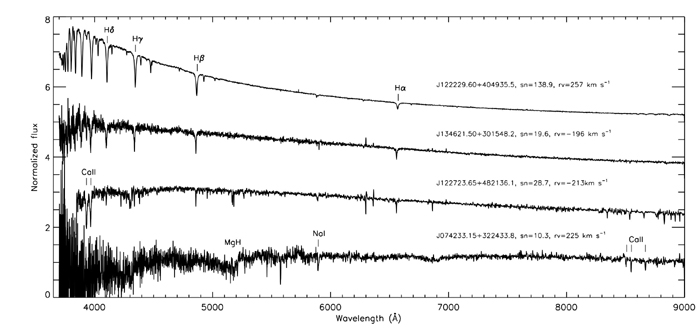Chinese astronomers have reported the discovery of 28 candidate high-velocity stars, stars that whizz around so fast that they may escape from the Milky Way galaxy. The superfast moving stars are found at distances of up to one third ofthe distance to the center of our Milky Way, with speeds in excess of 300km/s.This sample is the first and largest collection of such stars in the immediate solar neighborhood.
The observations were obtained withLAMOST,the Large Sky Area Multi-Object Fiber Spectroscopic Telescope (also called the Guoshoujing Telescope). The research was led by Dr. Jing Zhong and Prof. Li Chen from Shanghai Astronomical Observatory (SHAO), Chinese Academy of Sciences. The resultshave been published in the latest volume of The Astrophysical Journal Letters.
“Hypervelocity stars (HVSs) are stars which move sufficiently fast and finally escape from the Galaxy’s gravitational pull,“ said Dr. Jing Zhong.They might be formed whenstellar binaries get too close to the Galactic Center, when the black hole there captures one star and kicks out the other companion as a hypervelocity star. Such“three-body interactions”areone promising explanation for the origin of hypervelocity stars. Alternative explanations include three-body interactions among binary systems in star clusters or the disruption of stellar binaries in the main stellar disk of the Milky Way galaxy.
Until now, dozens of hypervelocity stars have been found in the Milky Way, but most of them are massive and luminous stars that are located far away from our solar system. “To place firm constraints on where these HVSs come from, it is imperative to construct a large HVS candidate sample made up of different types of stars,”said Dr. Jing Zhong.
Therefore, the 28 high-velocity candidates discovered among ~1,700,000 starsfrom the LAMOST Data Release One has both enlarged the size and increased the variety of stellar typesof current HVS candidate samples.The figure shows typical, representative HVS candidates.
In addition, preliminary results indeed show that most of these 28 high-velocity stars unlikely originate from the Galactic Center, and some may come from the Galactic Halo. So what are their exact origins ? “Most of them could not be due to interactions of binary stellar systems with the supermassive black hole in the Galactic Center. We have to consider other mechanisms,” said Dr. Jing Zhong.
“Our results have highlighted the great potential of discovering statistically large number of HVSs of different spectral types in the LAMOST survey data. LAMOST will continue to discover larger samples of HVSs, yielding a critical resource astronomers can use to better understand the nature of Galactic HVSs and their ejection mechanisms and also tobetter constrain Galactic structure. ” saidProf. JinliangHou, leader of the research group atSHAO.

Figure : Typical spectrarepresentative of our HVS candidates
LAMOST is a National Major Scientific Project built by the Chinese Academy of Sciences. Funding for the project has been provided by the National Development and Reform Commission. LAMOST is operated and managed by the National Astronomical Observatories, Chinese Academy of Sciences.
Science Contacts:
Jing Zhong, Shanghai Astronomical Observatory , Chinese Academy of Sciences,
jzhong@shao.ac.cn
Li Chen, Shanghai Astronomical Observatory,Chinese Academy of Sciences,
chenli@shao.ac.cn